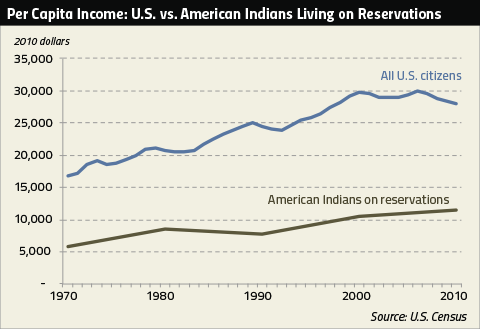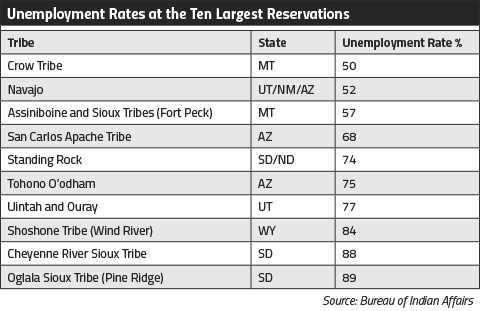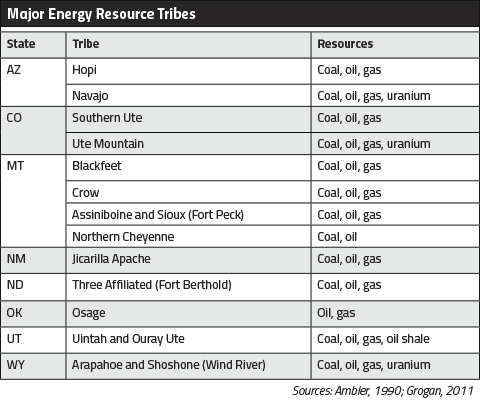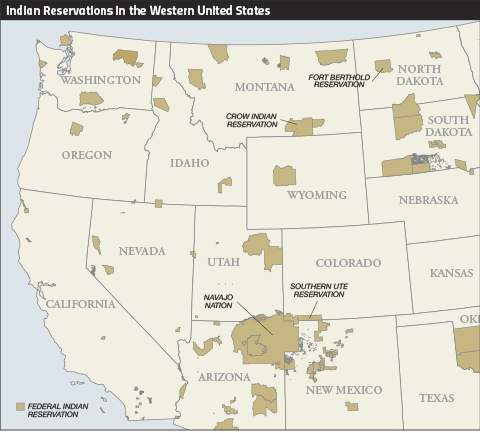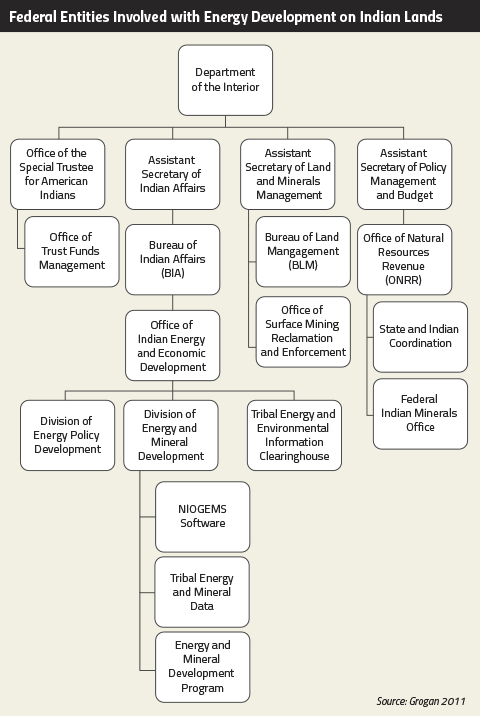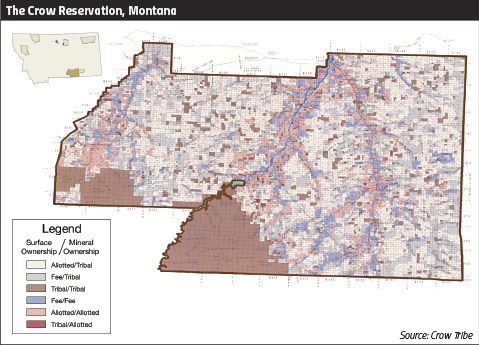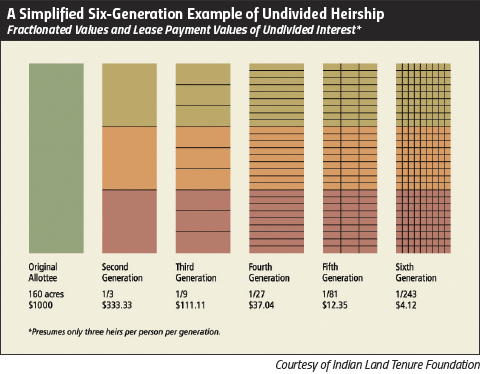Summary
- Native Americans lag behind other U.S. citizens on almost all economic, educational, and social outcomes.
- Indian poverty persists even though many reservations contain valuable natural resources, particularly energy resources.
- Despite these resources, the vast majority of tribal lands with energy potential remain undeveloped.
- The federal government makes it difficult for tribes to capitalize on their energy wealth. Reservation lands are managed in trust by the government and nearly every aspect of Indian energy development is controlled by federal agencies.
- A complex bureaucracy raises the cost of energy development on Indian lands, and new energy regulations are making it even more problematic for tribes to tap into their resources.
- In addition, the United States has failed to live up to its trust responsibilities by repeatedly mismanaging tribal assets.
- Despite these hurdles, some tribes are succeeding in developing energy resources for the benefit of tribal members.
- Tribes are gradually gaining more control over energy development on their land, but challenges remain.
- Policy reforms that enable tribes to control their own resources will give tribes the opportunity to unlock the tremendous wealth of Indian nations.
Reviews
Energy development presents a tremendous opportunity for many tribes, but the federal government often gets in the way. This PERC Policy Perspective is a must-read for anyone interested in helping Native Americans achieve the prosperity and the dignity they deserve.
— Senator Fred Thomas
Former Majority Leader, Montana State Legislature
Shawn Regan’s report is a well-researched and accurate review of the primary challenges to developing tribal energy resources for the long-term benefit of our people. The combination of multiple federal agencies involved in permitting any new energy development, along with highly fractionated ownership, makes the process pretty daunting for all but the most determined developers. Severe shortages of experienced staff at the Bureau of Indian Affairs make the process even more difficult and time-consuming.
— Darrin Old Coyote
Chairman, Crow Nation
Creating long-term economic development and functioning economies on Indian reservations is the most important issue facing tribal governments and tribal citizens today. Regan’s report explains the challenges facing tribes as they attempt to develop their energy resources.
— Robert J. Miller
Sandra Day O’Connor College of Law, Arizona State University
Chief Justice, Court of Appeals, Grand Ronde Tribe
Introduction
The Crow Nation sits above one of the largest coal reserves in the United States. An estimated nine billion tons of coal lie beneath the tribe’s reservation in southeastern Montana—a vast landscape of rolling hills at the edge of the Powder River Basin. Oil, natural gas, and various minerals are also found on the reservation, but it is coal that offers the greatest economic opportunity for the impoverished tribe.
Yet the tribe’s 13,000 members have little to show for their massive energy reserves. Although half of the tribe’s revenue comes from coal, most of it remains underground. Where development does occur, the process is slow and cumbersome. Unemployment approaches 50 percent on the reservation, and tribal members suffer from high rates of homelessness, crime, and inadequate housing.
This policy report focuses on why tribes such as the Crow struggle to capitalize on their energy resources. As energy production in the United States reaches record levels, tribes find themselves missing out on a revolution that is bringing economic opportunities to countless communities across the nation.
The energy resources beneath Indian lands are hardly trivial. Reservations contain almost 30 percent of the nation’s coal reserves west of the Mississippi, 50 percent of potential uranium reserves, and 20 percent of all known oil and gas reserves in the United States.1 The Council of Energy Resource Tribes, a tribal energy consortium, estimates Indian energy resources to be worth nearly $1.5 trillion.2
But federal control of Indian lands largely deprives tribes of the opportunity to benefit from such wealth. Throughout Indian Country, the vast majority of energy resources are undeveloped. Indian lands are managed in trust by the federal government. Any attempt to explore or develop resources on tribal lands must endure a costly rigmarole of bureaucracy and regulations. Making matters worse, the legacy of the federal trusteeship of Indian lands has left most tribes with complicated property institutions that are virtually anathema to economic growth.
The consequences are that even tribes with significant energy resources remain locked in a poverty trap. Their resources amount to “dead capital”—unable to generate benefits for tribal communities or the broader economy.3 Policy reforms that enable tribes to more easily convert their resources into “live capital” are sorely needed.
Energy development is just one of many strategies tribes may pursue to generate economic development. But its challenges are similar to the development challenges experienced throughout Indian Country. Understanding why tribes are often unable to control their own resources—and looking closely at a few tribes that are succeeding—provides insights into how tribes can unleash the tremendous wealth of Indian nations.
Native Americans lag behind other U.S. citizens on economic, educational, and social outcomes
American Indian reservations are some of the poorest communities in the United States. Thirty-nine percent live in poverty; unemployment is four times higher than the U.S. average; and incomes are less than half those of other U.S. citizens.4 Few economic opportunities exist in Indian Country, and many reservations rely almost entirely on federal support. Basic services that other Americans take for granted are often in short supply on reservations.
Native Americans also lag behind on almost every measure of economic and social wellbeing. Indians experience some of the shortest life expectancies and lowest levels of education of any group in the United States. Rates of violent crime and infant mortality are twice as high as the national average. Access to electricity, indoor plumbing, and adequate housing on reservations are at rates far below those of other U.S. households. Most Native American communities lack even the basic infrastructure necessary to support a functioning economy.5
Poverty persists even though many reservations contain valuable natural resources
Indian poverty persists despite the fact that many Native American reservations contain considerable energy wealth. The Department of the Interior recently estimated that Indian lands have the potential to produce 5.35 billion barrels of oil, 37.7 trillion cubic feet of natural gas, and 53 billion tons of coal. According to another estimate, Indian energy resources amount to 30 percent of the nation’s coal reserves west of the Mississippi, 50 percent of potential uranium reserves, and 20 percent of known oil and gas reserves.6
These resources can provide substantial economic opportunities for Native Americans if they choose to pursue energy development. In 2009, the Council of Energy Resource Tribes estimated that, at existing prices, the value of energy resources on Indian lands amounted to nearly $1.5 trillion.7 Recent technological advancements in hydraulic fracturing have only increased this potential value.
For many tribes, energy development is the primary revenue generator to fund education, infrastructure, and other public services on tribal land. Some also view energy development as a path to promoting tribal self-determination. Revenue from coal development on the Crow reservation in Montana, for instance, enables the tribe to control more of its own affairs apart from the federal government’s trusteeship of Indian lands.
Most tribal lands with energy resources remain undeveloped
Indian lands contain tremendous resource wealth, but the vast majority of tribal lands with energy resources remain undeveloped. The Department of the Interior estimates that energy development is taking place on only 2.1 million acres of Indian lands while an additional 15 million acres with energy potential remain untapped. In other words, 88 percent of Indian lands with energy potential have yet to be developed.8
The Fort Berthold reservation, for instance, is located at the center of the shale oil boom in North Dakota. Since 2010, hundreds of wells have been drilled on Fort Berthold, generating more than $40 million per month for the affiliated tribes in 2013. Just outside the reservation, however, roughly twice as many wells have been drilled per square mile. Lease payments to mineral owners are also higher off the reservation compared to tribal lands, leading many tribal members to question why they are not able to take full advantage of the energy boom occurring around them.9
American Indian Reservations
There are 565 federally recognized tribal governments in the United States today, 337 of which are located in the continental United States. These reservations range in size from the 20-acre Cedarville Rancheria in California to the Navajo Reservation in Arizona, which is roughly the size of West Virginia. All Indian land is held in trust by the U.S. government, which is responsible for managing the land for the benefit of Native Americans. Thirty-nine percent of people in the lower 48 states who self identify as American Indian live on reservations.
Federal control makes it difficult for tribes to capitalize on their energy wealth
Nearly every aspect of Indian energy development is controlled at some level by the federal government. The Secretary of the Interior must review and authorize all leases and agreements. Federal agencies also collect royalty payments on behalf of tribes and individual Indians and then redistribute them as royalty disbursements to Indian mineral owners.
The government’s authority over Indian lands traces its roots to the federal trusteeship established in the early nineteenth century. In 1831, Chief Justice John Marshall described tribes as “nations within a nation,” unable to negotiate treaties with foreign nations but implying that they retained the power to govern themselves. Marshall, however, went on to describe the relationship between tribes and the United States as “that of a ward to his guardian.”10 From this conception, the federal government became the trustee of Indian lands. The government holds the legal title to all Indian lands and is required to manage those lands for the benefit of all Indians.
Underlying the federal trust responsibility is the notion that tribes are incapable of managing their own lands. For much of the twentieth century, tribes had little or no control over their energy resources. Royalties and other payments were historically set by the Bureau of Indian Affairs. The agency consistently undervalued Indian resources and, by all accounts, did a poor job of negotiating and collecting royalty payments.11 In 1977, the Indian Policy Review Commission concluded that “the leases negotiated on behalf of Indians are among the poorest agreements ever made.”12
In practice, the federal trusteeship of Indian lands limits opportunities for tribal resource development and self-determination. Although tribes have gradually been granted more control over energy development decisions on their reservations, tribes still must acquire approval for every lease, a process that is notoriously slow and cumbersome. Many investors and energy companies simply avoid Indian lands altogether. In addition, Indians themselves are often skeptical of energy development due to past abuses and mismanagement by the government.
A complex bureaucracy raises the cost of energy development on Indian lands
On Indian lands, companies must go through at least four federal agencies and 49 steps to acquire a permit for energy development, compared to as few as four steps off reservations. The effect of this complicated bureaucracy is to raise the cost of entering into resource development agreements with tribes or individual Indians.13
The number of agencies and regulations involved in Indian energy development results in confusion, overlap, and a lack of coordination between agencies. The Bureau of Indian Affairs (BIA) has the primary authority over the management of Indian trust assets, but other agencies are involved in related issues such as revenue flows and oversight of resource extraction. These include the Bureau of Land Management, the Office of Natural Resources Revenue, the Office of the Special Trustee for American Indians, and if coal is involved, the Office of Surface Mining Reclamation and Enforcement.
It is not uncommon for several years to pass before the necessary approvals are acquired to begin energy development on Indian lands—a process that takes only a few months on private lands. At any time, a federal agency may demand more information or shut down development activity. Simply completing title search requests results in delays from the BIA. Indians have waited six years to receive title search reports that other Americans can get in a few days.14
Land Tenure on Indian Reservations
There are three primary forms of land tenure on Indian reservations, creating a complicated checkerboard pattern across many reservations. This checkerboard of ownership is found on both the surface and subsurface, which are often under different types of land tenure.
Tribal trust land – The U.S. government holds the legal title to tribal trust land, but the beneficial interest lies with the tribe. Tribal trust lands are managed collectively by the tribe and cannot be sold or used as collateral in the capital market.
Allotted (individual trust) land – The government holds the legal title to individual trust lands, but the beneficial interest remains with an individual Indian. These lands came about under the General Allotment Act of 1887, when some reservation lands were allotted to individual Indians but held in trust until the secretary of the Interior deemed the allottee “competent.” The allotment period ended in 1934, after which allotted lands that were not yet released from trusteeship remain under trust status. Like tribal trust lands, individual trust lands generally cannot be sold or used as collateral.
Fee-simple land–Lands that were allotted and released from trust status prior to 1934 remain as fee-simple property. These lands are like any other private land off the reservation. Owners have full legal title, and they are often owned by non-Indians.
Indian reservations have a complicated set of institutions that are detrimental to economic growth
In addition to a complex bureaucracy, the federal government has largely prevented tribes from developing institutional frameworks that promote economic growth. Reservations often lack clear property rights that support market activity, a legal system that offers certainty to potential investors, and an administrative framework that is predictable, transparent, and straightforward.
Outside of reservations, local, county, state, and federal governments provide stable property protection through law enforcement and legal institutions that support economic development. Inside reservations, however, legal jurisdictions and land tenure can vary widely, creating a complicated mosaic of private lands, individual trust lands, and tribal trust lands. Navigating this complex system of land ownership makes energy development as well as economic growth difficult.
Adding to the complicated mosaic of land tenure on reservations is the problem of fractionated land ownership. Fractionation results from individual trust lands that were passed in equal shares to multiple heirs. After several generations, ownership for many of these lands has become so fractionated that there are hundreds or even thousands of heirs, nearly all of whom must agree on energy development decisions. Fractionation raises the cost of developing resources on Indian lands, reduces the potential benefits for each individual owner, and results in much Indian land remaining idle.15
Fractionated ownership increases exponentially with each passing generation, meaning the problem is only getting worse. In 1992, the Government Accountability Office estimated the BIA’s annual recordkeeping costs for twelve reservations with fractionated ownership were between $40 and $50 million. By 2010, these costs had increased to $246 million per year due to increased fractionation.16 Today, there are 156,596 individual Indian land allotments and more than 4.7 million fractionated interests.17
The United States has repeatedly mismanaged Indian trust assets
Not only does the government’s trust authority raise the cost of energy development on Indian lands, it has a long history of not living up to its fiduciary responsibility. The recent class action suit Cobell v. Salazar alleged that the U.S. government incorrectly accounted for income from trust assets belonging to Indian landowners.18 Elouise Cobell, a director of a nonprofit Native American bank, filed the suit on behalf of thousands of Indians claiming that the United States mishandled billions of dollars of Indian trust assets. The case settled in 2009 with the government agreeing to pay individual Indians and tribes $3.4 billion, an amount far less than what was lost by the federal government.
The agencies responsible for overseeing energy development have little or no incentive to ensure that Indian income is properly documented and distributed. Inaccuracies and mismanagement are a persistent problem among the agencies involved in Indian Country. Partly as a result of this problem, the Minerals Management Service was disbanded in 2010 and replaced with the Office of Natural Resources Revenue. Whether this reform has improved the management of Indian trust assets remains to be seen.19
Energy regulations make it difficult for tribes to develop their resources
The Crow Tribe recently received approval from the Bureau of Indian Affairs to lease an additional 1.4 billion tons of coal on their reservation. The project would generate a source of long-term revenue for the tribe, but a host of regulations are making the reliability of this revenue source uncertain. In 2013, the Environmental Protection Agency issued strict limits on emissions from new coal-fired power plants, and the agency is planning more regulations for existing coal plants. The regulations are considered tough enough to prevent any new coal plants from being built in the United States.
With its domestic market for coal dwindling, the tribe and its development partners are planning to export the Crow’s coal to international markets, a prospect that largely depends on the construction of proposed export facilities in Oregon and Washington. Several cities near the proposed terminals and along the rail routes, however, are trying to stop coal exports, citing concerns about traffic congestion, quality of life, and climate change. Cities as far as Missoula, Montana—more than 500 miles from the proposed terminals—have petitioned the Army Corps of Engineers to expand the scope of its environmental assessment of coastal terminals. The cities want the agency to consider the environmental impacts of coal-rail shipments along the rail route.
“Today, the Crow Tribe has a rare window of opportunity before it, and we are doing everything in our power to take advantage of it before that window closes,” wrote Crow tribal chairman Darrin Old Coyote in a letter to the Missoula City Council. “For the Crow people, there are no jobs that compare to a coal job—the wages and benefits exceed anything else that is available.” Old Coyote believes the cities’ actions will further delay, and possibly halt, the construction of the facilities needed to export the tribe’s coal.20
Tribal energy development projects are subject to a number of federal regulations that do not apply on private lands. For instance, all tribal energy projects must go through National Environmental Policy Act review as well as cultural resource review under the National Historic Preservation Act. Both requirements add to the complexity of energy development on Indian lands, and neither requirement applies to development projects on private lands.
Stoney Anketell of the Fort Peck Reservation recently noted the frustration that such requirements can impose on tribes. At a meeting with several U.S. senators in 2013, Anketell explained how delays in archaeological assessments are impairing oil and gas development on the tribe’s reservation in Montana. “It takes too long to get leases approved, to get lease assignments approved, to get rights of way approved,” he said. “We’re not shortchanging the need for archaeological reviews, but on land that has been farmed for 70 years? It’s been tilled, plowed, planted, harvested. There’s no teepee rings.”21
Some tribes have succeeded in developing energy resources for the benefit of tribal members
Despite challenges, several tribes have succeeded in developing their resources for the benefit of tribal communities. These tribes have asserted their right to self-determination by taking an active role in resource development.
The Southern Ute Tribe in Colorado, for example, has experienced tremendous success developing its energy resources. The tribe owns and operates five energy companies and invests its energy revenues in a growth fund estimated to be worth $4 billion. Today, the tribe’s 1,400 members are each worth millions and receive dividends every year from the growth fund. The tribe’s expertise in energy development extends far beyond the reservation’s borders. Red Willow Production Co., a tribal-owned energy company, is engaged in oil, gas, and coal-bed methane extraction throughout the western United States, as well as offshore oil production in the Gulf of Mexico.22
The Southern Ute Tribe’s success began, perhaps surprisingly, after it declared a moratorium on issuing new energy leases in 1974. The tribal council recognized that the Department of the Interior failed to negotiate appropriate compensation for leases on the reservation. The tribe also lacked the expertise needed to make good decisions about energy development. Following the moratorium, the tribe contracted with outside experts to map and interpret the extent of its undeveloped resources. In the process, the tribe learned the value of their energy resources—and just how undervalued they were by the federal government.
After the tribe lifted the moratorium, it continued to consult with outside experts to guide energy development decisions on the reservation. The tribe contracted with attorneys, auditors, petroleum geologists, and others to take advantage of changes in federal policy that allowed tribes to negotiate their own energy leases. The tribe was also awarded several court settlements for the historic federal mismanagement of tribal assets and used the funds to create Red Willow Energy, its first energy business. By operating its own energy companies, the Southern Ute Tribe established an expertise in resource development and a reputation for good business practices and management.
The tribe’s approach to energy development is consistent with its values of self-determination. The tribe conducts its own audits and environmental assessments and operates a land division that is adept at navigating the complex layers of federal agencies that oversee energy projects. Revenues from energy development enable the tribe to pay for government and social services. The tribal-owned energy companies are able to take advantage of their exemption from many of the taxes non-Indian operators must pay. The tribal government has also made efforts to separate politics from business, enabling tribal companies to make their own business decisions.
Other tribes have succeeded in taking control of their natural resources. In 2013, the Navajo Nation purchased the Navajo Mine, the sole provider of coal to New Mexico’s Four Corners Generating Station. The mine has provided jobs to hundreds of tribal members and generates $41 million annually to the Navajo’s general fund. The tribe’s sovereign status affords it a lower tax burden, allowing the tribe to operate the mine more profitably than the previous non-Indian owner.23
In the 1990s, the Salish-Kootenai Confederated Tribes on Montana’s Flathead Reservation took over more than 100 programs previously run by federal agencies, including forest management. The tribes now earn $2.04 for every dollar they spend on timber management while the neighboring Lolo National Forest, managed by the federal government, receives only $1.10 for every dollar it spends. The Salish-Kootenai are also looking to purchase a dam on the reservation, thereby becoming the nation’s first tribal hydroelectric owners and operators. As with other forms of energy development, when tribes are afforded more control over natural resource management, the result has been significantly better management and higher output.24
Tribes are gaining more control over their land, but challenges remain
For much of the twentieth century, tribal energy development was almost entirely controlled by the federal government, with little benefit to tribal communities. Today, however, tribes are slowly gaining more control over the management of their natural resources.
In 1982, the Indian Mineral Development Act (IMDA) allowed tribes, but not allottees, to enter into any type of energy extraction agreement they desired. The act also allowed lease terms and royalty amounts to be determined by tribes rather than by federal agencies. Under IMDA agreements, tribes can negotiate leases, joint ventures, production sharing, and other agreements to develop their resources. These agreements are the primary means by which tribes lease lands for energy development today. Nonetheless, the federal trusteeship of Indian lands still requires that the BIA and other federal agencies review every development agreement and lease.25
Congress recently attempted to grant tribes even more control over energy development by allowing tribes to create Tribal Energy Resource Agreements (TERAs). Once a TERA is approved on tribal land, the tribe no longer needs to acquire separate approval for each business arrangement it makes in order to undertake resource development. Thus far, however, no tribe has entered into a TERA because, as one report notes, “the rules and regulations around implementing a TERA are exceedingly complex.”26
Likewise, the Helping Expedite and Advance Responsible Tribal Homeownership (HEARTH) Act of 2012 removes many of the regulatory hurdles for leasing tribal surface lands. The act enables tribes to create their own leasing regulations and requires the federal government to expedite its approval process. The policy, however, does not apply to “traditional” energy resources such as oil, gas, and minerals, so it offers no help with the obstacles and delays experienced by many tribes.27
Policy reforms can help tribes take control of their energy resources
The challenges facing tribes are multifaceted, but one thing is certain: The federal government has not lived up to its fiduciary responsibility to manage Indian lands for the benefit of tribes and their members. Tribes such as the Southern Ute and Salish-Kootenai have demonstrated their ability to manage their resources, and other tribes are eager to replicate their success. If policymakers continue to relinquish control over Indian affairs, tribes could more easily benefit from their energy wealth.
Several other policy proposals could support tribal sovereignty over energy development and address the obstacles imposed by the federal government. These include:
- Expanding the HEARTH Act to apply to traditional forms of subsurface energy development;
- Extending the federal government’s “one-stop shops,” which streamline the approval process for energy development on the Fort Berthold and Navajo reservations, to apply throughout Indian Country;
- Allowing individual Indian mineral owners to negotiate IMDA or TERA agreements and eliminate many of the steps required to process such leases;
- Repealing the $6,500 fee assessed by the Bureau of Land Management for processing each application to drill on Indian lands; and
- Streamlining the TERA approval process to make it a more practical and effective alternative for tribes.28
Another initiative underway from within Indian Country is the adoption of business and commercial laws that promote certainty for lenders and other businesses. One example that is used by a growing number of tribes is the Model Tribal Secured Transactions Act (MTSTA). This model commercial law has enabled tribes to harmonize their legal framework for many types of commercial transactions with the laws of state and other tribal jurisdictions. This has helped to reduce some of the uncertainty and confusion that lenders and investors often face when attempting to do business in Indian Country. Tribes that have adopted laws such as the MTSTA have done so to help reduce the cost of doing business in their jurisdictions and to promote access to capital and credit for their tribal and member-owned businesses. Today, however, many tribes still lack effective and relevant commercial laws.29
First Nations in Canada are exploring other policy solutions that address similar challenges to those faced by tribes in the United States. The proposed First Nation Property Ownership Initiative would give First Nations the opportunity to hold full legal title to their lands, just like any other Canadian. Each First Nation would have the option to choose whether to participate in the initiative. Those that participate would have the power to transfer the legal title to individuals while retaining First Nation jurisdiction over the land. A similar initiative in the United States would have dramatic implications for Native American economies, not the least of which would be to reduce the authority of the federal government over Indian resource development.30
Conclusion
As any student of American Indian history is aware, poverty is not a historical attribute of Native American culture. Indigenous societies were active stewards of their natural resources, often resulting in substantial wealth and prosperous economies. They participated in extensive trade networks and developed institutions of property ownership that produced both economic and cultural forms of wealth.31
Energy development provides just one way for tribes to reestablish the wealth and prosperity that many Native Americans once enjoyed. Tribes are certainly not required to develop their energy resources, but government agencies should not deprive them of the opportunity. Tribes such as the Northern Cheyenne in Montana have decided not to pursue energy development. But the neighboring Crow Tribe has repeatedly been unable to capitalize on its coal resources, due in large part to federal authority over Indian energy development.
The Bureau of Indian Affairs and other federal agencies severely restrict Indians’ rights to control their lands and, as a result, deny tribes the ability to benefit from their resources. Ron Crossguns of the Blackfeet tribe’s oil and gas department puts it this way: “It’s our right. We say yes or no. I don’t think the outside world should come out here and dictate to us what we should do with our properties.”32
The fundamental notion underlying the federal trusteeship—that tribes are unable to manage their lands—is flawed. When tribes are given the right to manage their own resources, they repeatedly demonstrate they can do so in ways that benefit tribes and generate broader economic growth. When they are freed from the oversight of the federal government, they are able to determine what is best for themselves and engage in economic activities that promote both their cultures and communities.
Sovereignty alone does not guarantee prosperity. With more control comes a greater responsibility to promote growth that benefits tribal communities and reduces reliance on the federal government. But as long as tribes are denied the right to control their own resources, they will remain locked in poverty and dependence. If tribes are given the dignity they deserve, they will have the opportunity to unleash the wealth of Indian nations.
Download the full report, including endnotes and references.

